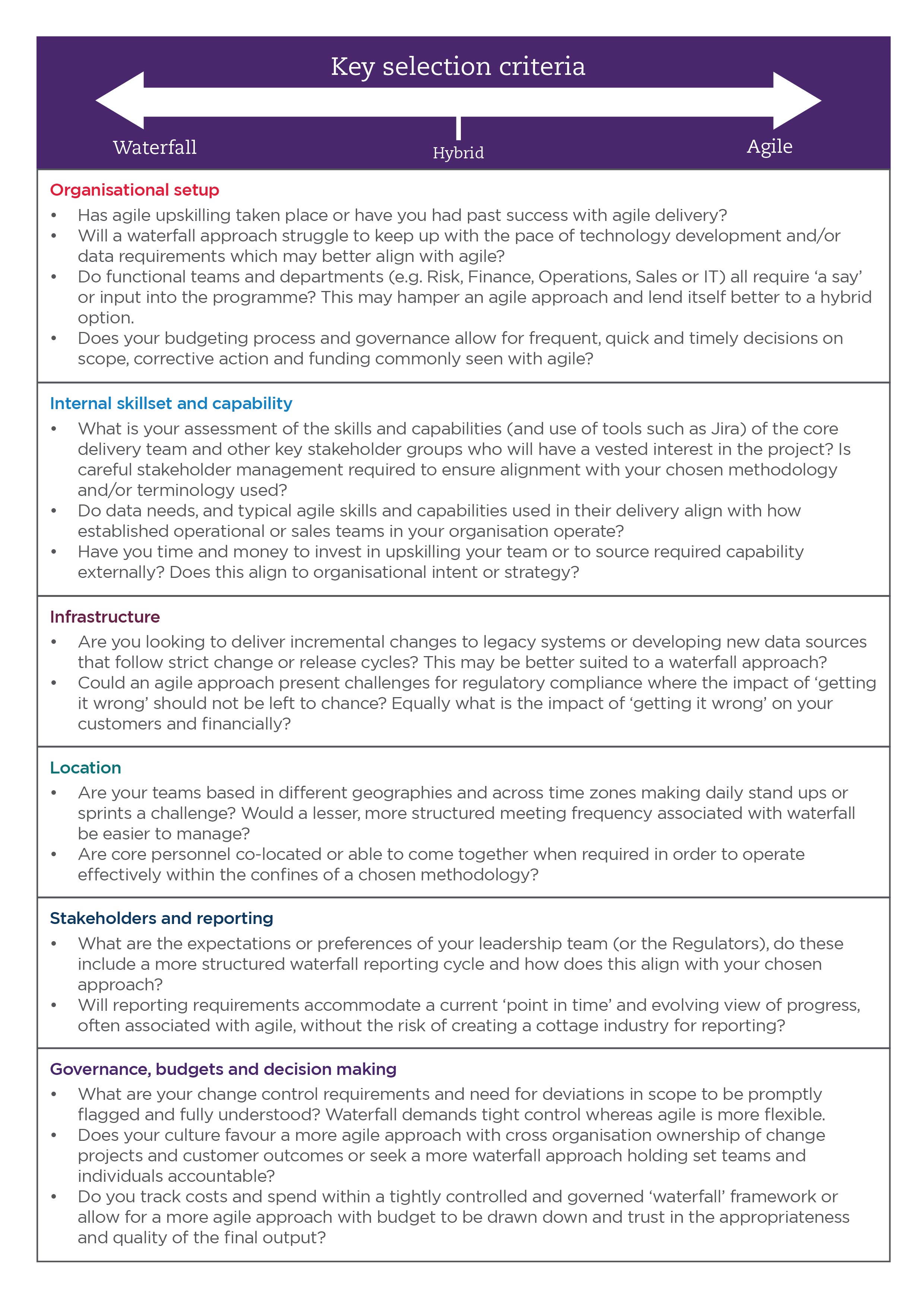A ‘Best of Breed’ approach to effectively managing change
Few people would argue of the need for change, especially like now in times of rapid change, yet despite that project failure is high, certainly at the first time of asking.
McKinsey state that the failure rate of major transformation projects is a staggering 70% whilst Gartner estimate this to be around 60% for big data projects. In recent times many organisations have rejected waterfall and embraced agile methodology and its associated terminology (sprints, scrums, scrum-master, Kanban, etc.). This has its place and value but often may not sit well with organisational governance and reporting required, particularly in a regulated or hierarchical environment.
In this article, we seek to remove the fashion and chance from the change methodology chosen. Instead, recognising that both agile and waterfall have their own merits, we will discuss the ideal conditions for each methodology to be most successful, and how to select the optimal hybrid or ‘best of breed’ approach that is tailored to best fit the specific organisation and the change portfolio/ initiative to be delivered.

The right conditions
So, what are the right conditions to get the best from a prescribed change methodology, and why knowing this can help organisations implement change successfully?
Selecting the ideal change methodology should be a key consideration before embarking on any change journey.
| Waterfall works best when... | Agile works best when... | |
|---|---|---|
| Time | Project timeframes are fixed (limiting change evolving over multiple financial years) or there are set deadlines. This is often the case with regulatory change. | Deliverables or outputs require frequent iteration or where a 'fail fast' approach is taken. This can be typical of IT led change lasting over a long period. |
| Cost | Budgets are fixed, requiring clear cost estimates. Inadvertently, this can lead to frontloading cost through upfront project planning and documentation. | There is trust that whilst the end result may not be clear ultimately this approach will produce outputs that meet requirements; and that teams can scale up or down in line with demand on resources. |
| Scope | Project scope and deliverables are clear and well-defined or where established organisational change capability demands a greater degree of control. | There is a clear vision or high-level requirement but less clarity on the end output itself, or where competitive market volatility results in evolving requirements. |
| Quality | Stage gates dictate the need for quality control testing at set intervals, or phases and a level of quality assurance over output. | There is a need for continuous testing and quality assurance throughout the project that takes precedence over ‘certainty’ of the final output based on upfront requirements. |
| Governance | Periodic formal reports to Steering Committees and Executives, in line with regular meeting rhythm, are required. | Leadership is happy to be kept abreast of progress through regular interactions with the project team. |
Why 'conditions are seldom right'
The very nature of change means that the conditions that make waterfall or agile successful are seldom all present. Many organisations too will have a preferred methodology making it easy to become a slave to a particular approach without proper alignment internally, and to the purpose of the change itself.
Agile can, and does, make a lot of sense in certain circumstances. However, to be fully effective it does require teams and leadership to get behind the jargon used (or replace it with their own), embrace aspects of iterative working, and trust in the end goal or outcome without clearly defined or documented requirements. Some organisations adapt well to this approach whilst for others this can present a challenge especially where there is an established change capability or where hierarchical decision making is engrained. There is also the potential for added complexity associated with the use of external vendors and contractors whose thinking may not always align with the organisation’s own.
On the other hand, many organisations will be familiar with a waterfall approach to delivery in which time, scope and costs are defined upfront, and supported with the knowledge that strict controls and governance are in place to manage subsequent changes and limit what could be perceived as ‘scope creep’. This is often the case within a regulatory environment with a mandatory requirement to ‘get it right’ within a fixed timeframe, and with failure to do so resulting in potentially costly remediation or redress. The same too can be said of IT system changes where delays to implementation can have a real impact – operationally, financially and reputationally!
These are just some of the challenges faced by organisations and explain why the best option is often to choose a ‘best of breed’ approach - one that leverages respective methodology strengths whilst also aligning to the specific needs of the organisation.
Selecting a 'Best of Breed' methodology
When selecting the right, or most appropriate, change methodology for your organisation there are a range of factors that should be considered. Whilst by no means exhaustive, the table below poses some questions, the answers to which will help determine whether your situation and specific needs are best suited to Waterfall, Agile or the optimal hybrid approach.

While it may be tempting to stick with one preferred methodology, a hybrid approach that combines the best of both waterfall and agile can often yield the best results. By asking the right questions upfront and carefully evaluating organisational needs, and those of the change itself, you can find a 'Best of Breed' approach that's right for you, and one that sets you up for success!
How we can help
Selecting the best approach to deliver change is not always straightforward and even the most experienced teams will face challenges along the way. However, recognising the factors that influence change and the conditions that make methodologies successful will help you select an optimal approach to deliver change in the most effective and efficient manner.
As experienced change professionals, we have helped a wide range of clients design, mobilise and execute complex change programmes. We are well used to defining requirements, unblocking delivery issues and creating key executive and board submissions. If you would like to discuss anything referenced in this article or if we can assist you more generally in delivering your change agenda, then please do not hesitate to get in touch with a member of our Consulting or Financial Services teams.



